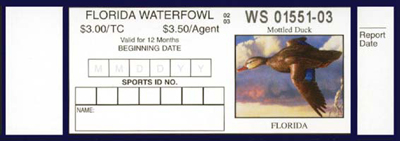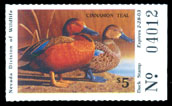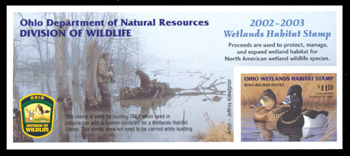 |
10% off on
web orders over $100 |
|
|

|
|
Beauty Contest Results For 2002 State Duck Stamps
Published 01/13/03
I see duck stamps all day, every day, and some leave a lasting impression - for better or worse. These are just my opinions of the class of 2002. They are certainly not intended to upset any of the talented artists who created their designs.
There were 44 states issuing stamps in 2002, the same number as in 2001.The states that did not have stamps were Georgia, Idaho, Missouri, Nebraska, New Mexico and Utah. Of these absentees, Georgia, Missouri and Nebraska should hang their heads in shame for not having successful programs. These are major duck areas, replete with hunters and collectors who would be willing to buy stamps.
All the states that did release stamps issued pictorials, except North Dakota. Their publisher had a fire that destroyed the printing presses, so they issued a text-only stamp this year.
All but two of the states with pictorial designs depicted waterfowl. Hawaii instead pictured a chukar partridge and Wyoming a river otter. These states therefore are not eligible for recognition in my little survey, since these animals are not migratory waterfowl. I'm thankful for this, since both the Hawaii and Wyoming state stamps offered mediocre images.
The most popular species depicted was canvasbacks (five), followed by green-winged teal (four) and widgeon (three). Two states - Illinois and South Carolina - featured retrievers, and Connecticut and Maryland have a lighthouse in the scene.
Five previous federal winners also had 2002 state designs to their credit, including Adam Grimm (for New York), Ron Louque (North Carolina), Jim Hautman (New Jersey) and Joe Hautman (for Texas). Bob Steiner once again led the pack with no fewer than three state stamps to his credit, for Alaska, California and Oregon.
Perhaps the award for the smallest image should be retired, since it appears Florida regularly reigns in this dubious area.
Figure 1 shows an enlargement of the entire adhesive, which features very nice artwork, but it is certainly not all that easy to see. The Sunshine State seems overwhelmed with paperwork, dedicating 60% of its stamp space for reporting data. Figure 2 shows the $7 Arkansas stamp. Its artwork is exceptional, and presents a realistic scene, but a few too many ducks.
I estimate there are about 200 ducks in all, even though many are reduced to no more than specks on the finished, issued adhesive. Perhaps the original artwork was larger and the scene was reduced. If so, it was crammed too much for clear recognition of the waterfowl. All due apologies to this state and its great program, which ranks among the very best in the nation.
Figure 3 shows this year's submission from Nevada - a hot state, in more ways than one. Its 2002 design wins the most obnoxious color award, being a loud orange-brown. When looking at all the 2002 state duck issues, the Nevada stamp is blinding.
Too bad, as the basic artwork showing a pair of common teal is lovely. But the color is much too harsh, albeit perhaps realistic for a desert environment.
The enigma award this year goes to Washington. The image of two green-winged teal taking flight from a pond is fantastically detailed, almost photographic. Each feather is so vivid and lifelike that you get the feeling you can reach out and touch them.
But take a look at what appears to be reeds in the background. The size of these reeds makes them more like trees, and the ducks are way too small and out of proportion to the setting. It's a puzzling image.
Louisiana wins the tax to the max award, for its burdensome tax on hunters from its neighboring states. Its non-resident stamp has a $25 face value, but their resident stamp is only $5.50.
It's plain that, in Louisiana, they don't want anybody shooting their ducks but folks who live there. Perhaps the bordering states - Texas, Arkansas, and Mississippi - should reciprocate by upping their non-resident fee on hunters from Louisiana, which is not the "Sportsman's Paradise" its license plates proclaim for out-of-staters.
In the no-award category, the artwork on Minnesota's migratory waterfowl stamp, pictured in Figure 5, is drab and lifeless, perhaps due to the printing process. The printed design is grainy and indistinct, and the unused self-adhesive $5 stamp is difficult to collect as well, because it comes on a backing sheet that measures about 4 inches by 8 inches (nearly all of which has been photographically cropped away in the image that is shown here).
The artwork does not appear to be the culprit in this dismaying design. Presentation is everything, they say, and this may be the stamp that proves just how it can hinder success.
All in all, this year's crop of stamps is below the aggregate norm. Several are rejects from the federal duck stamp contest. Others have disastrously dark designs, inordinately miniscule ducks or sheerly outrageous colors.
Figure 6 shows my least favorite design for 2002, the Montana stamp. The featured species is a sandhill crane, horses, cowboys, and mountains. The design also is vague, and the light pastel color makes it difficult to see details of the objects. The Montana Chamber of Commerce should be very pleased with the design, however.
Figure 7 below shows the winner of my award for the best state duck stamp, which goes to Ohio and artist Jeffery Klinefelter.
Take a look at the lifelike pair of ring-neck ducks serenely drifting on a pond in the $11 stamp. The artwork is very detailed and imaginative. The sheetlet containing the stamp is dollar-bill size, mimicking the federal self-adhesive type stamp, though the Ohio stamp is gummed.
The hunter and his faithful black lab wait in the shallows on a misty morning. The decoys are in place, the lab is anxious and the scene is real. This is a stamp any hunter or collector can enjoy, and certainly gives either a better feeling about spending $11, even if they get shut out in the field!
* * *
A complete list of addresses for state and national agencies that currently issue duck and conservation stamps is available for a 37¢ stamped, addressed No. 10 envelope from the writer, Bob Dumaine, Box 820087, Houston TX 77282.
Figure 1:

Figure 2:

Figure 3:

Figure 5:

Figure 6:

Figure 7:

|
|
|



















